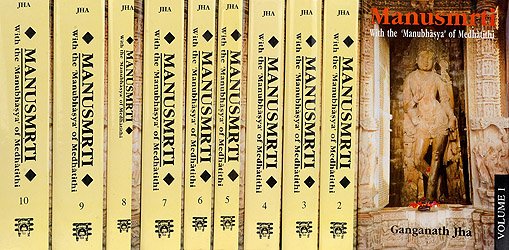Manusmriti with the Commentary of Medhatithi
by Ganganatha Jha | 1920 | 1,381,940 words | ISBN-10: 8120811550 | ISBN-13: 9788120811553
This is the English translation of the Manusmriti, which is a collection of Sanskrit verses dealing with ‘Dharma’, a collective name for human purpose, their duties and the law. Various topics will be dealt with, but this volume of the series includes 12 discourses (adhyaya). The commentary on this text by Medhatithi elaborately explains various t...
Verse 5.11
Sanskrit text, Unicode transliteration and English translation by Ganganath Jha:
क्रव्यादान् शकुनान् सर्वान्तथा ग्रामनिवासिनः ।
अनिर्दिष्टांश्चेकशफान् टिट्टिभं च विवर्जयेत् ॥ ११ ॥kravyādān śakunān sarvāntathā grāmanivāsinaḥ |
anirdiṣṭāṃścekaśaphān ṭiṭṭibhaṃ ca vivarjayet || 11 ||He shall avoid all carnivorous birds, and also those living in villages, the one-hoofed animals not specified, and also the Ṭiṭṭibha.—(11)
Medhātithi’s commentary (manubhāṣya):
‘Carnivorous’;—those that eat raw flesh; such as the Heron, the Vulture &c. What are meant are those that eat raw flesh only; and not those that eat both (raw and cooked flesh), such as the Peacock and the rest.
‘Living in villages’—even though they be not carnivorous.
‘One-hoofed animals;’—e.g., the Horse, the Mule, the Ass and so forth.
‘Not specified’;—i.e. those that have not been specified as fit to be eaten should not be eaten: those that have been so specified are lit to be eaten. For instance, it has been declared that ‘one who desires to obtain offspring shall eat the meat of the camel, the horse, the bear and the white ass’. [and here the one-hoofed animals, horse and white ass, are specified as fit to be eaten].
“The eatability of these animals is known only from this Śruti passage. And the presence of the term ‘specified’ in the verse would he understood to mean that the animals thus specified in the Vedic passage may be eaten even elsewhere (apart from Vedic sacrifices also); the meaning of the text being ‘one shall avoid those nut specified, but not those specified.’ As a matter of fact however, nowhere in the Smṛti have any one-hoofed animals been specified as fit to be eaten, with reference to which the term ‘not specified’ (of the text) could be explained. Hence it comes to this that ‘those not specified in the śruti are unfit to be eaten”.’
Our answer to the above is that such a sense of the Smṛti would be contrary to all usage. The term ‘not specified’ is a mere re-iterative reference.
‘Ṭiṭṭibha’—is a bird which is always screaming ‘ṭiṭ’, ‘ṭiṭ’. In most cases the names of birds are in imitation of their sounds: as says the Nirukta—‘The name Kāka is in imitation of the sound; such is the case with most bird-names.’—(11).
Explanatory notes by Ganganath Jha
This verse is quoted in Vīramitrodaya (Āhnika p. 540), which adds the following notes:—‘Kravyādaḥ’ are the vulture and other birds that eat raw flesh only, and also the peacock and others that eat both raw and cooked flesh;—‘grāmanivāsinaḥ’ stands for such village-birds as the pigeon and the like, which do not eat flesh;—the term Śakunīn is to be construed with both ‘kravyādaḥ’ and ‘grāmanivāsinaḥ’;—ekaśapha’ are the horse and other one-hoofed animals,—‘anirdiṣṭaḥ’ means ‘those that are not mentioned in the Śruti as fit for eating’; those that are mentioned as such should certainly be eaten; this refers to such sacrificial animals as are mentioned in the Vedic texts like the following:—‘One should sacrifice the horse to Tvaṣṭṛ’; which implies that the flesh of the horse so sacrificed must be eaten;—‘Ṭiṭṭibha’ is the name of the bird that makes the ‘ṭī ṭī’ sound.
It is quoted in Hemādri (Śrāddha, p. 582);—and in Smṛtisāroddhārā (p. 298).
Comparative notes by various authors
Gautamā (17.28-29)—‘Animals with two rows of teeth, hair-covered animals, hairless animals, one-hoofed animals, house-sparrow, Cakravāka and Haṃsa;—also crows, herons, vultures, kites, such water-fowls as have red feet or beaks, village-hens and village hogs.’
Baudhāyana (1.12.1-2).—‘Tame animals should not be eaten; nor carnivorous and tame birds.’
Āpastamba (1.17.29, 34).—‘One-hoofed animals, camels, gavaya, village-hog, śarabha and cows;—also carnivorous animals (are not to be eaten).
Vaśiṣṭha (14.48).—‘Among birds, those who seek food by scratching with feet, the web-footed ones, the Kalaviṅka, the water-hen, the flamingo... a vulture,... those feeding on flesh and those living about villages,’
Viṣṇu (51.28-30).—‘On eating the flesh of carnivorous animals and birds one should perform the Tapta-Kṛcchra; on eating the Kalaviṅka... one should fast for three nights;—also on eating one-footed animals and those with two rows of teeth.’
Yājñavalkya (1.172).—‘Carnivorous birds... one-hoofed animals, animals living about villages, etc., etc.’
Paiṭhīnasi (Aparārka, p. 248).—‘Cow, sheep, goat, horse, mule, ass and man—these seven are the gramya-paśus (grāmya-paśus?), animals living about villages.’
Hārīta (Do.).—‘They eat animals of the village and of the forest, sheep, goat, buffalo, deer, rhinoceros, etc., etc.’
Devala (Vīramitrodaya-Āhnika, p. 541).—‘Cranes, flamingoes, owls, crows, vultures, cocks, pigeons are birds that should not be eaten.’
Yama (Do, pp. 542 and 543).—‘Mushrooms. village-hogs, web-footed birds,—by eating these the twice-born becomes degraded; also by eating cows, horses, asses, camels, dogs, jackals, scratching birds, and pecking birds.’
Āpastamba (Do.).—‘Among scratching birds, the cock should not he eaten; among pecking birds, the Plava; also carnivorous birds and the flamingo, the Bhāsa, etc., etc.’
Parāśara (2.11).—‘On intentionally eating the flesh of the frog or the mouse, the twice-born becomes purified by living on barley-meal for one day.’
